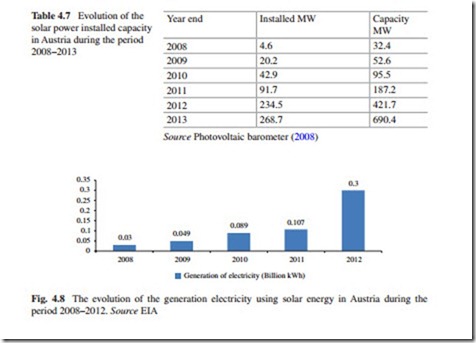Austria
Hydropower and biomass are the major renewable energy sources used in Austria for the generation of electricity. Beside of these two energy sources, Austria is one of the pioneering countries in the thermal use of solar energy, the production of biodiesel, and the use of ambient heat. Combined with the increasing use of renewables, the design and production of hydropower plants, solar thermal instal- lations, biomass boilers as well as the manufacturing of components for the use of wind energy and solar PV increased in the past years (Faninger and Gerhard 2005).
Despite its well-developed solar PV industry, Austria remains an untapped market, according to the Global Market Outlook for Photovoltaic until 2015 report. For years, it has been limited by fixed annual budget limitations. Various support measures exist at national and regional levels, the main being the national FiT, which is granted for thirteen years. It is constrained by a limitation on annual expenses that cannot exceed €2.1 million.
Solar PV deployment in Austria had been rather modest for many years,8 while in other European countries, such as Germany, Italy or Spain, installations were booming with new records year after year until 2011. The flow has turned in 2012. New solar PV installations jumped to 234.5 MW per year in Austria in an overall declining European solar market. The EPIA forecasts, that Austria, together with other midsized countries, will contribute significantly to European solar PV deployment in the coming years. In 2012, the total solar power capacity installed in the country reached 421.7 MW, which represents 1.86 % of the total energy capacity installed and 2.48 % of the total renewable capacity installed in the country in that year. Austria occupies the place number nine at world level due the total solar power capacity installed (0.42 % of the world solar capacity installed) and the place number 12 at regional level (0.6 % of the total). The annual growth rate in the solar power sector during the past ten years reached 37.74 %, and in all of these years, the solar power capacity installed increases systematically. It is expected that this trend will continue in the future.
The evolution of the solar power installed capacity in Austria during the period 2008–2013 is shown in Table 4.7.
Through the Climate and Energy Fund, some projects are financed each year at country level using bidding procedures. Some grants are also allocated for both on- and off-grid applications. In spite of its high potential, the market will remain very small unless the current limitations is lifted soon. This alone could ensure a strong solar PV development in Austria.
Electricity Generation Using Solar Energy
The evolution of the generation of electricity using solar energy in Austria during the period 2008–2012 is shown in Fig. 4.8.
According to Fig. 4.8, the use of solar energy in Austria for the generation of electricity during the period 2008–2012 increased tenfold. It is expected that the use of solar energy for the generation of electricity will continue to increase during the coming years as a result of the decision of the Austrian government to increase the use of renewable energy sources for this specific purpose, with the aim of reducing the CO2 emission and the negative effect on the environment.
